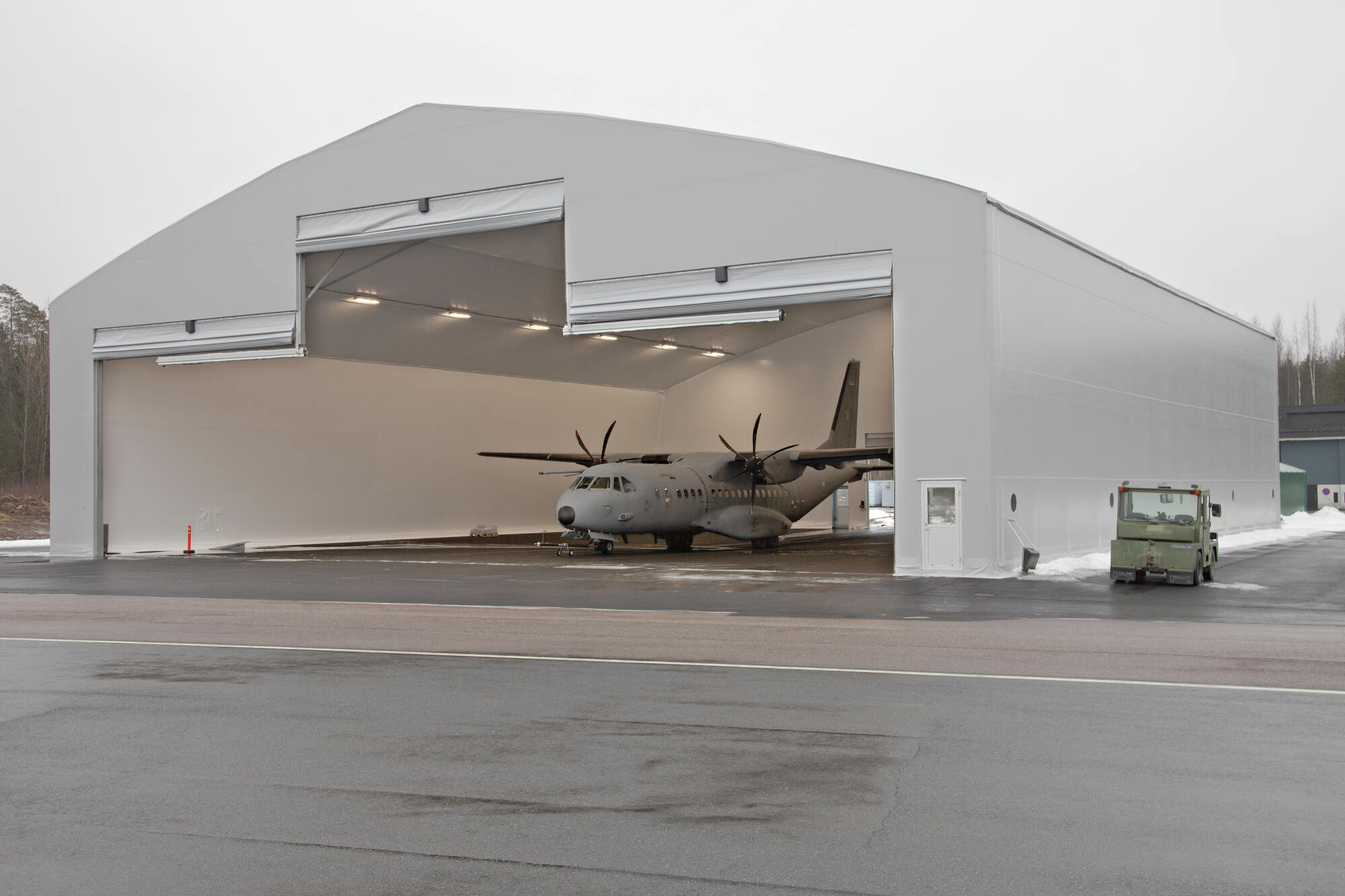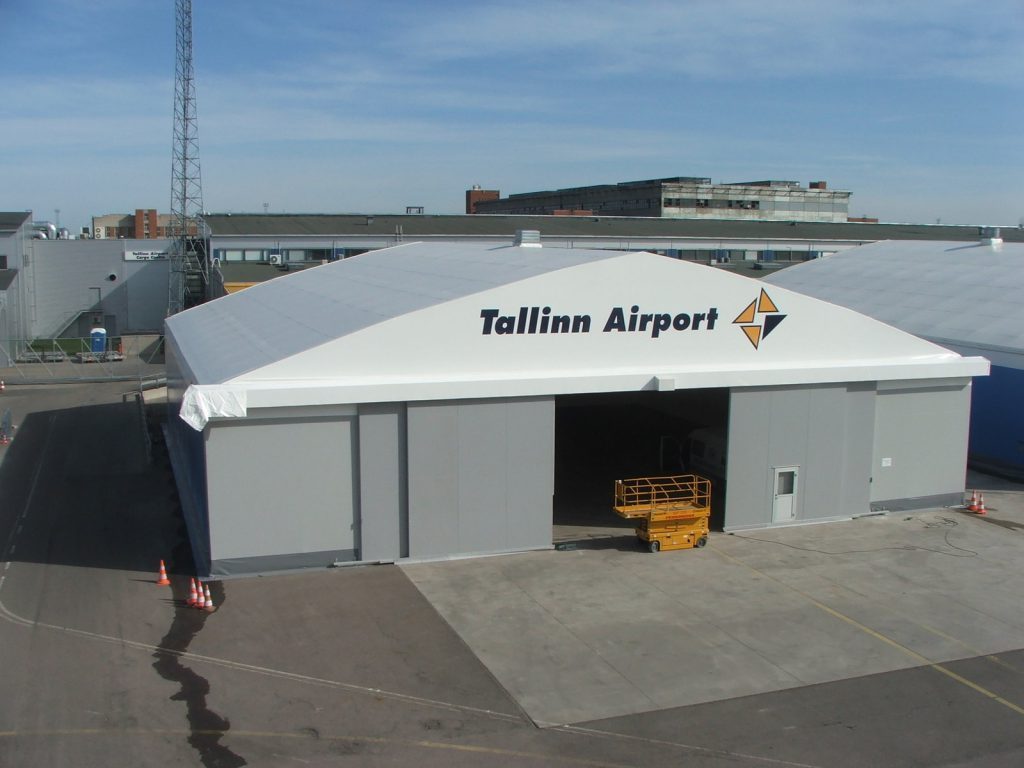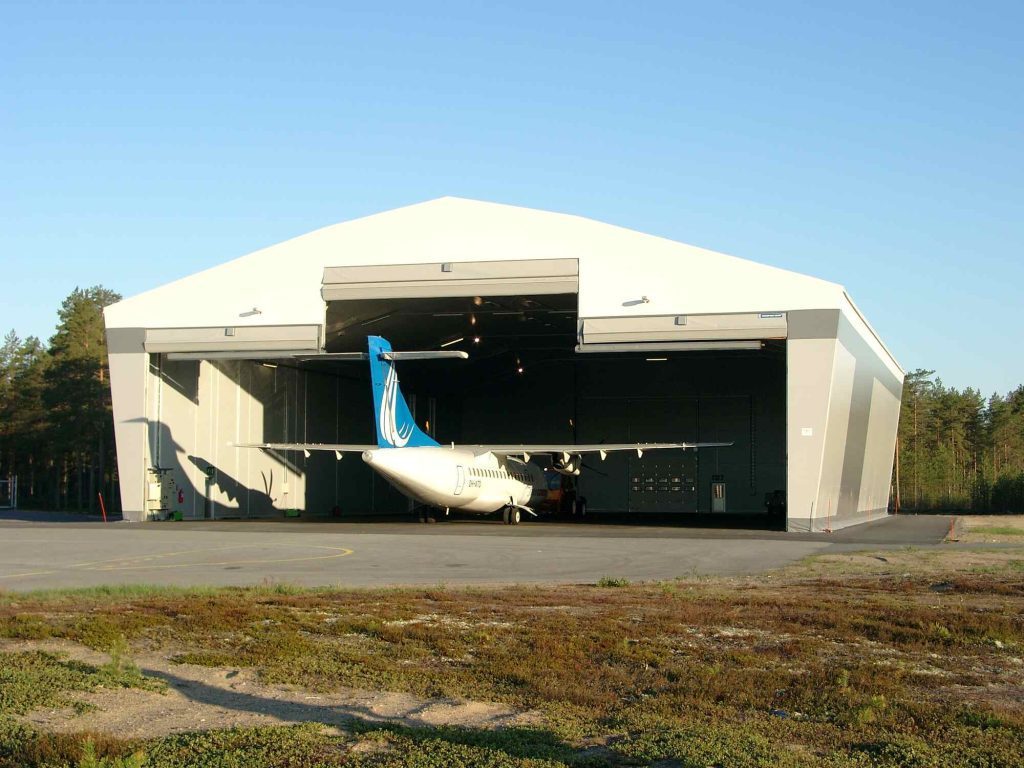Aircraft Hangar Types

Aircraft hangars play a crucial role in aviation by providing safe, weather-resistant environments for aircraft storage and maintenance. From traditional structures to modern innovations, hangars have evolved to meet the growing demands of the aviation industry.
As an expert in tensile fabric structures, Collinson Tensile (the sole partner of Best Hall, Finland) specialises in designing and constructing long-lasting, durable aircraft hangars across the UK and Ireland. Within this guide, we’ll explore the various types of aircraft hangars and their unique characteristics.
Understanding the Different Types of Aircraft Hangars
1. T-Hangars
T-Hangars are compact, efficient structures designed primarily for single-engine aircraft. Their ‘T’ shape allows for space-saving storage of multiple planes in a limited area. These hangars are highly favoured by owners of light aircraft, as they offer excellent protection in a relatively small footprint.
2. Rectangular Hangars

One of the most common designs, rectangular hangars provide clear-span interiors, ideal for a variety of aviation needs. Whether used for storage, maintenance, or housing corporate jets, rectangular hangars offer flexibility and ease of construction. These structures are popular among fixed-base operators (FBOs) and aviation businesses looking for multi-purpose spaces.
3. Cantilever Hangars
Cantilever hangars, with their column-free interiors, provide large, open spaces that are perfect for storing wide-body aircraft, jets, and commercial airliners. The design allows for maximum floor space without obstructions, facilitating the easy movement of planes and equipment. This makes cantilever hangars a go-to option for organisations that require significant space for larger aircraft or heavy maintenance operations.
4. Arch Hangars
Arch hangars are visually striking, featuring curvilinear roofs that distribute weight efficiently across the structure. This design is not only aesthetically pleasing but also provides extra vertical space, which can be crucial for accommodating larger aircraft with tall tail sections. The inherent strength of arch hangars makes them durable options, well-suited to harsher environments or areas where strength and weather resilience are priorities.
5. Military Hangars
Built to withstand the demands of military operations, these hangars are constructed with resilience, security, and functionality in mind. Military hangars are often equipped with advanced security systems, blast-resistant materials, and the capability to house specialised military-grade aircraft.
6. Portable and Mobile Hangars
Portable and mobile hangars are gaining popularity due to their flexibility and quick assembly. These structures can be easily transported and deployed, making them ideal for temporary operations, remote airfields, or emergency relief situations. Their adaptability makes them a key solution for projects where permanent infrastructure is impractical or unnecessary.
7. Fabric (Tensile) Hangars

As experts in tensile fabric structures, we’ve seen firsthand how fabric hangars offer cutting-edge solutions for modern aviation needs. These permanent tensile fabric hangars are made from a metal framework (usually steel) and a fabric envelope that stretches over that framework. Fabric hangars can be cost-effective, easy to install, and provide excellent protection against the elements.
Tensile fabric hangars also promote energy efficiency by allowing natural light to illuminate the interior, reducing the need for artificial lighting. These hangars are corrosion-resistant and require minimal maintenance, making them an increasingly popular choice for aviation companies looking to balance cost with longevity.
8. Maintenance Hangars
Maintenance hangars are specifically designed for aircraft repair and upkeep, offering large, clear-span spaces that accommodate equipment, tools, and personnel. These hangars are often equipped with specialised features such as high ceilings for cranes, enhanced lighting for precision work, and integrated systems for ventilation and fire suppression. Maintenance hangars are essential for airlines, MRO (Maintenance, Repair, and Overhaul) facilities, and aviation businesses that need dedicated spaces for servicing their aircraft.
9. Corporate Hangars
Corporate hangars are designed for private and business jets, offering a blend of functionality and luxury. These hangars are typically equipped with high-end features such as climate control, advanced security systems, and customized interiors to house valuable aircraft. In addition to storage, corporate hangars may include office spaces, lounges, and meeting rooms to cater to the needs of executives and VIP passengers.
10. Helicopter Hangars

Helicopter hangars are specialised structures built to accommodate the unique design and operational needs of helicopters. These hangars are often smaller than traditional aircraft hangars but feature high ceilings and large doors to allow for easy rotor clearance. Helicopter hangars are commonly used by search-and-rescue teams, medical services, and corporate helicopter owners. They can also include maintenance areas for rotorcraft-specific repairs and equipment storage.
Why Choose a Tensile Fabric Hangar?
Tensile fabric hangars are rapidly becoming a popular choice in the aviation industry due to their flexibility, durability, and cost-effectiveness. These structures use advanced materials and construction techniques to offer many advantages over traditional steel or concrete hangars. Let’s explore why tensile fabric hangars are an ideal solution for your aviation needs.
Large-Span Rectangular Hangars
Tensile fabric structures can achieve impressive clear spans of up to 100 metres, making them perfect for large aircraft and diverse aviation operations. The ability to cover such a wide area without internal support creates a versatile space that can accommodate anything from private jets to commercial airliners. Whether for storage or maintenance, these large-span hangars provide the necessary room for easy manoeuvrability, equipment setup, and operational efficiency.
Column-Free Interiors
One of the key benefits of tensile fabric hangars is the elimination of internal columns, which can obstruct the movement of aircraft and equipment. With a column-free interior, these hangars offer uninterrupted floor space, making it easier to move planes in and out, set up maintenance bays, or store multiple aircraft. This design flexibility allows for seamless operations, which is especially important in high-traffic environments like maintenance facilities or busy airfields.
Multiple Uses
Tensile fabric hangars are highly adaptable, serving a wide range of aviation needs. As well as being able to accommodate light aircraft to larger commercial and private aircraft, tensile structures can be customised to suit different requirements. Such as:
- Corporate Hangars: Tensile fabric hangars can be outfitted with climate control, advanced security systems, and bespoke interiors, making them ideal for private jet owners and businesses looking for premium aircraft storage.
- Maintenance Hangars: These hangars offer the large, open spaces necessary for performing aircraft repairs, routine inspections, and other technical work. The ease of installation and ability to create expansive work areas make tensile fabric hangars an excellent option for MRO (Maintenance, Repair, and Overhaul) facilities.
- Helicopter Hangars: Tensile structures are perfect for helicopter operations due to their customizable door designs and flexible layouts. The large, clear-span areas allow for easy rotor clearance and ensure safe, efficient operations for helicopters of all sizes.
Durability and Efficiency
Tensile fabric hangars are built to withstand harsh weather conditions while remaining low-maintenance and cost-effective. The materials used in these structures are lightweight yet incredibly strong, offering excellent durability and resistance to corrosion. Additionally, the translucent properties of the fabric can help reduce energy costs by allowing natural light to illuminate the interior, reducing the need for artificial lighting.
Conclusion
Tensile fabric hangars offer a versatile, durable, and cost-effective solution for a variety of aviation applications. With their ability to accommodate large-span, column-free interiors, they are ideal for everything from corporate jets to helicopter operations and maintenance facilities. Understanding the different types of aircraft hangars available is key to making an informed decision based on your specific needs—whether you’re looking for a small, efficient space for light aircraft or a large, clear-span hangar for commercial airliners.
At Collinson Tensile, we leverage over 20 years of expertise in tensile fabric construction to deliver high-quality, durable hangars that meet the demands of modern aviation. We provide tailored solutions to ensure your aircraft are protected and operational. For more information or to discuss your hangar project, get in touch with our team today.
